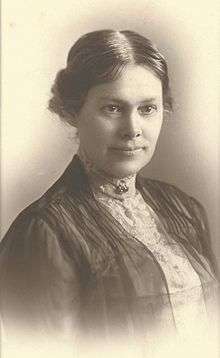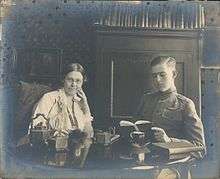Margaret Eliza Maltby
| Margaret Eliza Maltby | |
|---|---|
 | |
| Born |
December 10, 1860 Bristolville, Ohio |
| Died |
May 3, 1944 (aged 83) New York City |
| Nationality | United States |
| Fields | physics |
| Known for | Measurement of high electrolytic resistances and of the conductivity of very dilute solutions. |
| Spouse | Never married |
| Children |
Philip Randolph Meyer (1897- 1986)[1] |
Margaret Eliza Maltby (10 December 1860 – 3 May 1944) was an American physicist notable for measurement of high electrolytic resistances and conductivity of very dilute solutions. She was born in Bristolville, Ohio, and died in New York City.[2]
Education
- A.B. Oberlin College 1882
- A.M. Oberlin College 1891
- B.S. Massachusetts Institute of Technology 1891
- Ph.D. University of Göttingen 1895 under Friedrich Kohlrausch and Walther Hermann Nernst.[3]
In 1887, Maltby enrolled as a "special student" at MIT because the institution did not accept female students. She was the first woman to earn a B.S. degree at MIT in 1891. She was the first American woman allowed to take a degree at the University of Göttingen in 1895.[4] She was also the first woman to receive a Ph.D. in physics from Göttingen; in fact, she was the first woman to obtain a physics Ph.D. from any German university. After she received her doctorate she worked at the newly founded Institut für Physikalische Chemie at Göttingen under Walther Hermann Nernst.[5][6] Invited back to Germany in 1898 to work at the Physikalisch-Technische Reichsanstalt in Charlottenburg, Maltby was research assistant to the President, Friedrich Kohlrausch, and helped set the research methodology in the field of conductivity.[5]
Career
- 1889-93 Instructor, Physics Department, Wellesley College
- 1896-97 Associate Professor, Physics Department, Wellesley College [7] [8]
- 1897-98 Instructor of Mathematics and Physics, Lake Erie College
- 1898-99 Research Assistant, Physikalisch-Technische Reichsanstalt, Charlottenburg, Germany
- 1900-03 Instructor, Chemistry Department, Barnard College, Columbia University
- 1903-10 Adjunct Professor, Physics Department, Barnard College
- 1910-13 Assistant Professor, Barnard College
- 1913-31 Associate Professor and Chair, Physics Department, Barnard College
Work
Most of her significant research occurred before she began teaching at Barnard College, a women's college founded in 1889, where her involvement in administration left her little time for research. Maltby was a mentor to her students, vigorously extending efforts to support their professional advancement. During her 31 years of teaching at Barnard, and the nearly 20 years that she was chair of the physics department, Maltby took a great interest in her students' learning, even introducing physics courses for non-physicists, including probably the first course in the physics of music.
There are many examples of her efforts to support the professional advancement of female physicists. As chair of the American Association of University Women (AAUW) Committee on Fellowships, Maltby administered funds that supported women actively engaged in physics research during the early part of their careers. Since women were not eligible for many research fellowships because of their gender, the AAUW Fellowships were critical for maintaining a cadre of women physicists. Maltby's enormous effort contributed to the Fellowships' preservation.
Despite Barnard College's Dean's Rule that stated, "the College cannot afford to have women on the staff to whom the college work is secondary; the College is not willing to stamp with approval a woman to whom self-elected home duties can be secondary," Maltby supported women's efforts to do both. As chair of the Physics Department, she vigorously opposed the forced resignation of Harriet Brooks when she planned to marry.
Physicist and History of Science interviewer Katharine Sopka wrote that her students greatly admired her. One wrote her that, "Professor Maltby was my mentor--a gracious lady--a friend and a counselor. Her most memorable advice to me was not to forego marriage for a career--which advice I followed and lived happily ever after."[9] Maltby never married.
The first edition of American Men of Science, published in 1906, recognized her name with star to note her as one of the country's top scientists.[10]
Maltby's scientific publications
- "Methode zur Bestimmung grosser elektrolytischer Widerstände," Zeitschrift für Physikalische Chemie 18:133-158 (1895).
- "Methode zur Bestimmung der Periode electrischer Schwingungen," AnPhCh 61: 553 (1897).
- "Das elektrische Leitvermögen wässriger Lösungen von Alkali-Chloriden und Nitraten," in Wissenschaftliche Abhandlungen der Physikalisch-Technischen Reichsanstalt. Vol. 3: 156 (1900) with F. Kohlrausch.
Maltby's publications on education
- "A Few Points of Comparison between German and American Universities," PAColA 2ds. 62: 1 (1896).
- "The Relation of Physics and Chemistry to the College Science Courses," Columbia Quarterly 18: 56 (Dec. 1915).
- "History of Fellowships Awarded by the American Association of University Women, 1888-1929". New York: Columbia University Press, 1929.
Honors
- First woman to receive a Ph.D. in physics from Göttingen University 1895
- American Association of University Women European Fellow 1895-96
- Fellow American Association for the Advancement of Science 1889
- Fellow American Physical Society 1900
- Appeared in first seven editions of American Men of Science 1906
- Margaret E. Maltby Fellowship established by the American Association of University Women 1926[2] [4]

Personal life
"Maltby herself never married but nevertheless enjoyed some of the pleasures of motherhood and grandmotherhood through the adoption in 1901 of the orphaned son of a close friend." --Katharine Sopka.[9]
The quote above was the polite fiction accepted by Maltby's friends and associates in the academic world of Barnard College and Columbia University in the first half of the 20th century.
And fiction it was.
Autosomal DNA tests of Margaret Maltby's "adopted" son's two daughters, available at Ancestry.com., show their descent from ancestral families of Maltby's mother and of her father, evident in the DNA his daughters share with numerous other descendants of those families.[1] It is clear that Philip Randolph Meyer was Maltby's natural son. He was born in June 1897, six months after Maltby's sudden resignation at the end of the Fall 1896 term "in consequence of an accident"[8] from her post as Associate Professor of Physics at Wellesley College.
Maltby reappeared to resume her teaching career as an instructor at Lake Erie College in September 1897. She returned to a research position in Germany in 1898, leaving her son in the care of a friend with a well fitted-out nursery. Upon her return to the United States in 1901, she was reunited with her son.[1] She took up her post at Barnard College that same year.
She spent the rest of her life in the Columbia University Morningside Heights community except for a year's sabbatical at the Cavendish Laboratory, Cambridge University, in 1910, a short-lived attempt to relocate to California for her retirement, and frequent and extensive traveling and touring.
Notes
- 1 2 3 Gill, Raymond. "Genetics & Genealogy - Miss Maltby and Her Ward: Using DNA to Investigate a Family Mystery". American Ancestors. New England Historic Genealogical Society. vol. 17, no. 2 (Spring/Summer 2016): pp. 49–52.
- 1 2 "Margaret Maltby 1860-1944". "Contributions of 20th Century Women to Physics." CWP at UCLA. Retrieved 2016-05-28.
- ↑ Bartel, Hans-Georg and Rudolf P. Huebener (2007). Walther Nernst: Pioneer of Physics and of Chemistry. Singapore: World Scientific Publishing Co. Pte. Ltd. ISBN 981-256-560-4. pp. 102-104
- 1 2 "Margaret Eliza Maltby (1860-1944)". Smithsonian Institution Archives. Retrieved 2015-04-20.
- 1 2 Proffitt, Pamela, Ed. (1996). Modern Women Scientists. Farmington Hills, Mich: Gale Group. ISBN 0-7876-3900-1. pp 353-354
- ↑ Zott, Regine, Hrsg. (1996). Wilhelm Ostwald und Walther Nernst in ihren Briefen sowie in denen einiger Zeitgenossen. Berlin: Verlag für Wissenschafts- und Regionalgeschichte Dr. Michael Engel. ISBN 3-929134-11-X. pp. 62, 63, 65, 93, 95
- ↑ Wellesley College (1900). Wellesley College Record, 1875-1900. Wellesley, Mass., The College. p. 12.
- 1 2 Wellesley College (1897). "Report of the President 1897" Presidents' Reports, Book 2. pp. 6, 17
- 1 2 Lotze, Barbara, Ed. Making Contributions: An Historical Overview of Women's Role in Physics, "Women Physicists in Past Generations" by Katherine R. Sopka. College Park, Maryland: American Association of Physics Teachers. ISBN 0-917853-09-1. pp. 11-13
- ↑ Cattell, James McKeen, Ed. (1906). American Men of Science: A Biographical Directory (1st ed.). New York: Science Press. p. 208.
References
- Scott E. Barr, "Margaret Eliza Maltby," American Journal of Physics, 28, pp. 474–475, 1960.